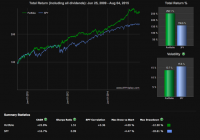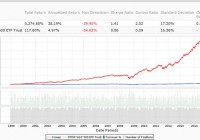A Simple SPY Top-Off Portfolio
Summary A one-third UPRO, two-thirds cash portfolio mimics SPY (with some small tracking error and a net 0.32% expense ratio). Putting the two-thirds cash allocation in a short-term bond ETF like BSV allows you to recoup the 0.32% expense ratio, plus earn a little extra. Since UPRO’s inception in 2009, not including trading costs, the UPRO/BSV top-off portfolio has generated a CAGR of 15.3%, compared to SPY’s 14.3%. Going back to 1994, a 3x SPY/short-term bond portfolio has beaten SPY in 21 out of 22 years, with an average 3.1% annual outperformance. For S&P 500 investors, I see little downside to implementing a UPRO/BSV portfolio to consistently beat SPY. Background I’ve written a few articles on combining leveraged ETFs with cash or the underlying index to realize portfolios with certain properties (see for example Build Your Own Leveraged ETF ). There are a few neat things you can accomplish: Achieve any leverage between 0 and the highest multiple leveraged ETF available. Achieve a leverage multiple of an existing ETF by combining cash with a higher multiple leveraged ETF, potentially reducing your net expense ratio. Achieve net leverage of 1 by holding for example one-third of your money in a 3x leveraged ETF, and the remaining two-thirds in cash. The last point leads to the natural question: If I can mimic the SPDR S&P 500 Trust ETF ( SPY) while tying up only 33% of my available balance, why not put the remaining 67% to work in a low-risk fund that generates a few extra percentage points in growth every year? One-Third UPRO, Two-Thirds BSV The ProShares UltraPro S&P 500 ETF (NYSEARCA: UPRO ) is a leveraged ETF that aims to multiply daily S&P 500 gains by a factor of 3. It has an expense ratio of 0.95%. The Vanguard Short-Term Bond ETF (NYSEARCA: BSV ) is a short-term bond fund with an expense ratio of 0.10%. Let’s take a look at how a one-third UPRO, two-thirds BSV portfolio would have performed over these funds’ mutual lifetimes. (click to enlarge) Sure enough we get a nice little top-off with the UPRO/BSV strategy. The compound annual growth rate was 14.3% for SPY, 15.3% for UPRO/BSV rebalanced daily with no fees, and 14.8% for UPRO/BSV rebalanced whenever the effective leverage went below 0.9 or above 1.1 (with a $7 trading fee). Sharpe ratios were 0.058, 0.063, and 0.061, respectively. Of course, the greater your portfolio’s balance, the more your growth would look like the blue curve rather than the red one, since you can rebalance very frequently without trading costs hurting you very much. I know, an extra 1% isn’t that much. But just like a 1% expense ratio can really hurt you over time, a 1% boost every year can really make a big difference. If you go year by year you see that UPRO/BSV tends to tack on an extra 1-2% to SPY’s annual growth, although it doesn’t always. Annual growth of SPY and UPRO/BSV portfolios. Year SPY BSV UPRO/BSV (no fees) UPRO/BSV (fees) 2009 22.3% 2.1% 23.7% 23.4% 2010 13.1% 3.8% 15.5% 14.0% 2011 0.9% 3.0% 2.3% 2.2% 2012 14.2% 1.5% 14.9% 14.2% 2013 29.0% 0.2% 28.3% 28.1% 2014 14.6% 1.4% 14.9% 14.9% 2015 -7.1% 1.4% -6.6% -7.2% One-Third 3x Leveraged ETF, Two-Thirds VBISX We can only look at UPRO/BSV back to 2009, but it’s easy enough to switch UPRO for a hypothetical 3x SPY ETF, and switch BSV for the Vanguard Short-Term Bond Index Fund Investor Shares (MUTF: VBISX ), so we can go back further. For the 3x SPY ETF, we’ll assume no tracking error and a 0.95% annual expense ratio, mimicking UPRO. The correlation between daily gains for the simulated 3x SPY ETF and UPRO since UPRO’s inception is 0.997. The correlation between monthly gains for BSV and VBISX since BSV’s inception is 0.963. Let’s see how one-third 3x SPY, two-thirds VBISX would have performed since 1994. (click to enlarge) The top-off portfolios achieved nearly double the balance of SPY over the 20.5-year period. Sharpe ratios were 0.033 for SPY, 0.043 for 3x SPY/VBISX with no fees, and 0.043 for 3x SPY/VBISX with fees. Of course it is important to note that VBISX has done really well since 1994, with a CAGR of 4.4%. Note that the top-off portfolio with fees beat SPY in 21 out of 22 years (all except 1994), and on average beat SPY by 3.1%. You can see the consistent annual outperformance below. (click to enlarge) Another way to visualize the outperformance of the top-off portfolio relative to SPY: (click to enlarge) A Portfolio Optimization View I came to the one-third 3x SPY, two-thirds short-term bonds portfolio from the perspective of mimicking SPY by combining a 3x leveraged ETF with cash, but then putting the cash to work to gain an extra few percentage points. But you can also view the strategy from a portfolio optimization perspective. A short-term bond fund like BSV has positive alpha simply from the fact that it yields a certain small percentage annually from maturing bonds of various durations. So in periods when SPY is flat, BSV still tends to grow (i.e. it has positive alpha). Indeed if you regress monthly VBISX gains vs. monthly SPY gains going back to 1994, VBISX has alpha of 0.0036 (p < 0.001), meaning it gains on average 0.36% in months when SPY is flat. Typical Stocks/Bonds Story? It is well-known that holding both stocks and bonds tends to improve risk-adjusted returns. But if you hold an S&P 500 index fund in addition to bonds, your net beta drops below 1 and you often sacrifice raw returns. The UPRO/BSV approach is unique in that it keeps beta at 1 (assuming BSV has no correlation with SPY), while increasing both risk-adjusted and raw returns. Something like a free lunch. Upping the Ante A natural extension of the UPRO/BSV top-off strategy is combining UPRO with a longer duration bond fund. For example I like one-third UPRO, two-thirds BND, for a bigger top-off. But BND is much more variable than BSV, and also much more sensitive to rising interest rates. Another way to "up the ante" so to speak is to aim for some leverage greater than 1, say 1.25 or 1.5. You can still combine UPRO with BSV to get some extra growth at any leverage below 3, but the greater your net leverage, the greater your allocation to UPRO has to be, and the less you have left over to grow in BSV. Risks Many investors may not be comfortable with a portfolio that requires a significant allocation to a leveraged fund. Indeed, there are risks associated with leveraged funds. In particular: If SPY ever experiences an intraday loss of one-third its opening price, you could lose the entire balance in the leveraged ETF. While leveraged S&P 500 ETFs like UPRO have historically had very little tracking error, daily gains may occasionally deviate from the target multiple. In between rebalancing periods, you may suffer some irrecoverable losses due to volatility decay. It is important to note that while the top-off strategy uses leveraged ETFs, the target net leverage for the portfolio is 1. In that sense, the portfolio is not prone to the greatly amplified volatility (and potentially catastrophic drawdowns) usually associated with leveraged ETFs. It is very important to understand these issues before implementing the SPY top-off strategy. Indeed, many investors may decide that the potential for slightly higher annual returns does not justify the added risks. I personally believe that the risk/reward for the strategy is favorable. Conclusions A one-third UPRO, two-thirds BSV portfolio should behave very similarly to a 100% SPY portfolio, but often generate an extra 1-4% annual return. You'll have to monitor your effective leverage (multiply your UPRO allocation by 3) and rebalance when it deviates much from 1, but for a reasonably sized portfolio this should not detract much from your extra gains relative to SPY. Of course, you don't have to use UPRO and BSV. Other 3x S&P 500 ETFs and short-term bond funds should perform similarly. And if you want an extra boost, consider pairing the leveraged ETF with an intermediate or long-term bond fund, or a total bond fund. But your annual gains will be more variable, and you may suffer losses as interest rates rise. I am currently implementing the SPY top-off strategy with UPRO and BND, but may switch to UPRO and BSV in the near future for a more consistent, albeit smaller, bonus. Ideally, I'll beat SPY by a little bit every year, and eventually be happy.

